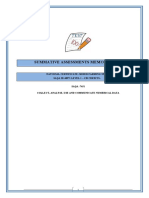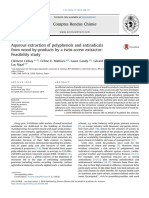Professional Documents
Culture Documents
Mouse Report
Mouse Report
Uploaded by
Sanjivee SachinOriginal Description:
Original Title
Copyright
Available Formats
Share this document
Did you find this document useful?
Is this content inappropriate?
Report this DocumentCopyright:
Available Formats
Mouse Report
Mouse Report
Uploaded by
Sanjivee SachinCopyright:
Available Formats
2.
Develop your recommendations
Recommendations are more likely to be implemented if they are:
● Supported by evidence: Clarify how the recommendations build on your findings. It can help to
structure them in the same order as the findings.
● Specific: Explain exactly what action needs to be taken, how, and when.
● Realistic and achievable: It can be helpful to categorise your recommendations according to which are
easier and harder to implement, attaching timescales to each. More ‘difficult’ recommendations may
need budget or staff changes, for example. These should still be stated, but so should their implications.
● Prioritised: You may want to split your recommendations into ‘essential’ versus ‘optional’, or ‘for
consideration’ versus ‘for action’.
3. Review your report
Allow time for review and iteration, and involve other staff members, as well as beneficiaries and
external stakeholders, where useful. You could ask them to help refine your research conclusions or
suggest and prioritise recommendations based on a draft of the report. Or, if you’re planning to share
the report widely, you may want someone outside your sector to review the whole thing to ensure it’s
clear to external audiences. Take care that people base their recommendations on the evidence, not
their own interests or preoccupations.
When reviewing your report, bear in mind the six principles of good impact reporting:
1. Clarity: Make sure the reader can easily understand the organisation through a coherent narrative
that connects your aims, plans, activities, and results. Avoid jargon and long lists of statistics. Explain any
terminology that might be unfamiliar. Be as clear and precise as possible.
2. Accessibility: Ensure the relevant information can be found by anyone who looks for it, in a range of
formats suitable for different stakeholders. Think about what your audiences need and want to know, as
well as what you want them to know.
3. Transparency: Be clear about how you reached your conclusions and be open about what you can and
can’t say based on your data. If you weren't able to hear from, or your sample over- or under-
represents, a particular group, say so.
4. Accountability: Reporting is designed to connect with stakeholders, partners, and beneficiaries to tell
them what they need to know, and provide reassurance. Demonstrate that you are accountable, and be
honest about where you’re going next.
5. Verifiability: Claims about impact should be backed up, allowing others to review the information.
Providing a range of qualitative and quantitative evidence is key. Avoid over-claiming your role and
You might also like
- Ebook PDF The Life Span Human Development For Helping Professionals 5th Edition PDFDocument41 pagesEbook PDF The Life Span Human Development For Helping Professionals 5th Edition PDFrhea.brewster81396% (47)
- 7451 - Summative Assessment MemorandumDocument15 pages7451 - Summative Assessment MemorandumForbet100% (1)
- Green and White Basic Presentation TemplateDocument17 pagesGreen and White Basic Presentation Templatethisisme nowNo ratings yet
- Business CommunicationDocument4 pagesBusiness CommunicationPrayas ZanzariNo ratings yet
- Business CommunicationDocument5 pagesBusiness CommunicationVinitaNo ratings yet
- Business CommunicationDocument13 pagesBusiness Communicationsrivastavaanmol64No ratings yet
- Ajay Raina - BU3073 - BR - PresentationDocument5 pagesAjay Raina - BU3073 - BR - PresentationAnmol GuptaNo ratings yet
- Feasibility Study ModuleDocument15 pagesFeasibility Study ModuleJessa Dela Cruz SahagunNo ratings yet
- Mid 1Document4 pagesMid 1Tafhimul IslamNo ratings yet
- Name: Ifraz Mohammed Student ID: 20231449 Tutor: Nurul Iman Unit: BSBHRM611Document6 pagesName: Ifraz Mohammed Student ID: 20231449 Tutor: Nurul Iman Unit: BSBHRM611Ifraz MohammadNo ratings yet
- Final Report in ENG1OODocument6 pagesFinal Report in ENG1OOHanierose LaguindabNo ratings yet
- ODDocument4 pagesODJahid HasanNo ratings yet
- Business Communication 2nd SemDocument8 pagesBusiness Communication 2nd Semjayprakash singhNo ratings yet
- Business CommunicationDocument7 pagesBusiness CommunicationPankti VisariaNo ratings yet
- SkillsDocument9 pagesSkillsVeni VijayNo ratings yet
- KLX7P0J4P622NTHUDocument7 pagesKLX7P0J4P622NTHUishanNo ratings yet
- Advocacy Group 6 - Lesson 7Document21 pagesAdvocacy Group 6 - Lesson 7Claire Erica GaniganNo ratings yet
- Business CommunicationDocument9 pagesBusiness Communicationharminder kaurNo ratings yet
- Business CommunicationDocument9 pagesBusiness Communicationyjayai2309No ratings yet
- Introduction To ResearchDocument6 pagesIntroduction To ResearchthuyflamNo ratings yet
- Business CommunicationDocument8 pagesBusiness CommunicationSwapnil CallaNo ratings yet
- Bussiness CommunicationDocument10 pagesBussiness Communicationbs357192No ratings yet
- B. Building Goodwill Through Public RelationsDocument5 pagesB. Building Goodwill Through Public RelationsCamille Gene SolidumNo ratings yet
- Assignment 4 AnswerDocument5 pagesAssignment 4 AnswerPallavi GaurNo ratings yet
- BSBLDR403 Assessor Marking Guide V1.0Document14 pagesBSBLDR403 Assessor Marking Guide V1.0Mahamood FaisalNo ratings yet
- Different Tools For Data GatheringDocument14 pagesDifferent Tools For Data GatheringMariane ValenzuelaNo ratings yet
- Effective CommunicationsDocument36 pagesEffective Communicationserudite_0206No ratings yet
- Business CommunicationDocument7 pagesBusiness Communicationrishabh4yadavNo ratings yet
- NHS Assignment.Document4 pagesNHS Assignment.amandeep singhNo ratings yet
- A Document That Offers A Solution To A Problem or A Course of Action in Response To A Need. - Read Our Book Page 73Document3 pagesA Document That Offers A Solution To A Problem or A Course of Action in Response To A Need. - Read Our Book Page 73Grace ValilaNo ratings yet
- Module Iv - Data CollectionDocument8 pagesModule Iv - Data CollectionSUICIDE SQUAD THAMIZH YTNo ratings yet
- Problem Solution and PersuasionDocument6 pagesProblem Solution and PersuasionSamantha CarpioNo ratings yet
- TechniquesDocument15 pagesTechniqueskritika negiNo ratings yet
- Fundamental Concepts of Report WritingDocument85 pagesFundamental Concepts of Report WritingStephen Sumipo BastatasNo ratings yet
- Business CommunicationDocument9 pagesBusiness Communicationmithilapednekar309No ratings yet
- Business CommunicationDocument7 pagesBusiness CommunicationRãjput Višhãl Singh ČhàûhåñNo ratings yet
- ADL 10 Marketing Research V3 2Document11 pagesADL 10 Marketing Research V3 2SUVAYU67% (9)
- Case Study: Quality Assurance and Training Assessors 1. Organization and PlanningDocument3 pagesCase Study: Quality Assurance and Training Assessors 1. Organization and PlanningjustusNo ratings yet
- GEC324 Technical CommunicationDocument22 pagesGEC324 Technical CommunicationAIDYNo ratings yet
- Audit BAFM 22 47Document17 pagesAudit BAFM 22 47Haly NoorNo ratings yet
- Bsbcrt611 w1 Team 3 d1 (A1)Document9 pagesBsbcrt611 w1 Team 3 d1 (A1)Paola Almanza CerraNo ratings yet
- COU104A - StudyGuide - Week 10Document16 pagesCOU104A - StudyGuide - Week 10kevinwoods786_863449No ratings yet
- Research Methods in Business - Study MaterialsDocument81 pagesResearch Methods in Business - Study Materialskannan KNo ratings yet
- Communication Strategy - Preview: Strategic Communication Is Based On Four Interactive VariablesDocument44 pagesCommunication Strategy - Preview: Strategic Communication Is Based On Four Interactive VariablesimchitraNo ratings yet
- What Is The Definition of Research DesignDocument5 pagesWhat Is The Definition of Research Designcindy ignacioNo ratings yet
- Research Mid TermDocument10 pagesResearch Mid TermBrady ShipletNo ratings yet
- 7 Methods To Collect InformationDocument3 pages7 Methods To Collect InformationHussin SarjuNo ratings yet
- BSBLDR502Document25 pagesBSBLDR502tvatNo ratings yet
- How To Write A Policy Brief: Foreign Policy Analysis Gabriela de La Paz, Ph. DDocument18 pagesHow To Write A Policy Brief: Foreign Policy Analysis Gabriela de La Paz, Ph. DKAREN JULIANA LAMPREA QUIROGANo ratings yet
- The Importance of Research in Public RelationsDocument6 pagesThe Importance of Research in Public RelationsDevlia Mona Riza50% (2)
- The Ideal Learning ExperienceDocument5 pagesThe Ideal Learning ExperienceRousha_itiNo ratings yet
- Innovation Storytelling - ToolDocument9 pagesInnovation Storytelling - ToolVictor Vi-kee MurithiNo ratings yet
- Entrepreneurship 2Document7 pagesEntrepreneurship 2Far MieNo ratings yet
- Business Research Methodology: Explain The Concept of Hypothesis Testing With An ExampleDocument19 pagesBusiness Research Methodology: Explain The Concept of Hypothesis Testing With An ExampleBhavvyam BhatnagarNo ratings yet
- Change Management Lectures 11 - 12Document41 pagesChange Management Lectures 11 - 12FarhangaizNo ratings yet
- Research Methods and Design: Additional Inputs: Welcome To Powerpoint Slides ForDocument18 pagesResearch Methods and Design: Additional Inputs: Welcome To Powerpoint Slides ForParth Rajesh ShethNo ratings yet
- Report TemplateDocument4 pagesReport TemplateBeyourself9999No ratings yet
- Proposal WritingDocument49 pagesProposal WritingPrateek SinghNo ratings yet
- Getting To Know The MarketDocument37 pagesGetting To Know The MarketLorrane SubaNo ratings yet
- Checklist 3 Monitoring Evaluation and Reporting 1Document3 pagesChecklist 3 Monitoring Evaluation and Reporting 1Anna DyNo ratings yet
- Reviewer in App 002 - Module 19-22Document6 pagesReviewer in App 002 - Module 19-22Vivian Marie MenorNo ratings yet
- BCC SyllabusDocument1 pageBCC SyllabusSanjivee SachinNo ratings yet
- Vasanth ProjectDocument10 pagesVasanth ProjectSanjivee SachinNo ratings yet
- Vasanth KumarDocument22 pagesVasanth KumarSanjivee SachinNo ratings yet
- Multimeter Working PrincipalsDocument3 pagesMultimeter Working PrincipalsSanjivee SachinNo ratings yet
- Rectifier: Half-Wave RectificationDocument2 pagesRectifier: Half-Wave RectificationSanjivee SachinNo ratings yet
- Diode Working PrincipalDocument1 pageDiode Working PrincipalSanjivee Sachin100% (1)
- ShinWell Automation Industry ChennaiDocument2 pagesShinWell Automation Industry ChennaiSanjivee SachinNo ratings yet
- Capaciter Working PrincipalDocument2 pagesCapaciter Working PrincipalSanjivee SachinNo ratings yet
- Curriculum Vitae: (Speak, Read and Write) (Speak, Read and Write)Document3 pagesCurriculum Vitae: (Speak, Read and Write) (Speak, Read and Write)Sanjivee SachinNo ratings yet
- Amudhan Kannan RESAPTION LISTDocument3 pagesAmudhan Kannan RESAPTION LISTSanjivee SachinNo ratings yet
- Project Report Speed Control of Induction MotorDocument47 pagesProject Report Speed Control of Induction MotorSanjivee SachinNo ratings yet
- Answer These Questions Correctly.: Nama: Icut Dawani Kelas: C1 Sistem Informasi Uas B. InggrisDocument2 pagesAnswer These Questions Correctly.: Nama: Icut Dawani Kelas: C1 Sistem Informasi Uas B. InggrisIcut DawaniNo ratings yet
- Catalogue February 2023Document32 pagesCatalogue February 2023Anna KrichunNo ratings yet
- Forecasting With Dummy Variables: Group 6 Evin Whittington Travis MennDocument9 pagesForecasting With Dummy Variables: Group 6 Evin Whittington Travis MennMila Grace Lavilla PacienteNo ratings yet
- Engineering Mechanics Question Bank - 2021-22Document35 pagesEngineering Mechanics Question Bank - 2021-22Naman JainNo ratings yet
- Caribou Biosciences Strategic AnalysisDocument13 pagesCaribou Biosciences Strategic Analysisapi-649553353No ratings yet
- Special Collections: Jotun Powder CoatingsDocument10 pagesSpecial Collections: Jotun Powder Coatingsviet nguyen caoNo ratings yet
- SF 7.2D Items To Be Checked During On-Site Visit For Placement VerificationDocument6 pagesSF 7.2D Items To Be Checked During On-Site Visit For Placement VerificationFMS QTEAMNo ratings yet
- SSOP For HR in EmergenciesDocument61 pagesSSOP For HR in EmergenciesVolodymyr DOBROVOLSKYINo ratings yet
- COCO Help - Heat ExchangerDocument1 pageCOCO Help - Heat ExchangerrvramanNo ratings yet
- Rainforest WebquestDocument2 pagesRainforest WebquestPatrick ThorntonNo ratings yet
- Physical Adversarial Textures That Fool Visual Object TrackingDocument19 pagesPhysical Adversarial Textures That Fool Visual Object TrackingNaufal SuryantoNo ratings yet
- 1MRK506382-UEN - en - K - Technical Manual, Line Distance Protection REL650 Version 2.2Document956 pages1MRK506382-UEN - en - K - Technical Manual, Line Distance Protection REL650 Version 2.2Imran KhanNo ratings yet
- Wp1 Evidence and PolicyDocument21 pagesWp1 Evidence and PolicyJosé Luis Castillo BNo ratings yet
- Mre2019 43 101 Obrien FinalDocument136 pagesMre2019 43 101 Obrien FinalAndré Carlos SilvaNo ratings yet
- Effect of Sex and Body Region On The Follicular Profile of Corriedale SheepDocument10 pagesEffect of Sex and Body Region On The Follicular Profile of Corriedale SheepIndian Journal of Veterinary and Animal Sciences RNo ratings yet
- Aqueous Extraction of Polyphenols and Antiradicals From Wood - 2014 - Comptes Re - DoneDocument8 pagesAqueous Extraction of Polyphenols and Antiradicals From Wood - 2014 - Comptes Re - DoneremyNo ratings yet
- The UltimateDocument2 pagesThe UltimateBiantoroKunartoNo ratings yet
- Accountable - Fernan - Princess - Quarter2 - Module 4Document8 pagesAccountable - Fernan - Princess - Quarter2 - Module 4Hannah Kim SingzonNo ratings yet
- Plagerissm MetakaolinDocument28 pagesPlagerissm Metakaolinsiva 17No ratings yet
- Materials and Processes For Agricultural and Biosystems EngineeringDocument19 pagesMaterials and Processes For Agricultural and Biosystems EngineeringMelanie D. Aquino BaguioNo ratings yet
- Barco Medical Display Systems - Product Catalog PDFDocument64 pagesBarco Medical Display Systems - Product Catalog PDFSantiago ScarsiNo ratings yet
- Erwin Medina-Investigatory Science ProjectDocument3 pagesErwin Medina-Investigatory Science ProjectErwin Labayog MedinaNo ratings yet
- Masony NC II Prog AchievDocument5 pagesMasony NC II Prog AchievRosalina ObiasadaNo ratings yet
- BIO095 Chapter 2: Gene Technology Compiled By: Noor Akmal Abd WahabDocument4 pagesBIO095 Chapter 2: Gene Technology Compiled By: Noor Akmal Abd WahabnazirafitriNo ratings yet
- GSPS LessonsDocument17 pagesGSPS LessonscordisaberonNo ratings yet
- Legacy - Wasteland AlmanacDocument33 pagesLegacy - Wasteland AlmanacВлад «Befly» Мирошниченко100% (3)
- Merritt Morning Market 3663 - March 16Document2 pagesMerritt Morning Market 3663 - March 16Kim LeclairNo ratings yet




































































































